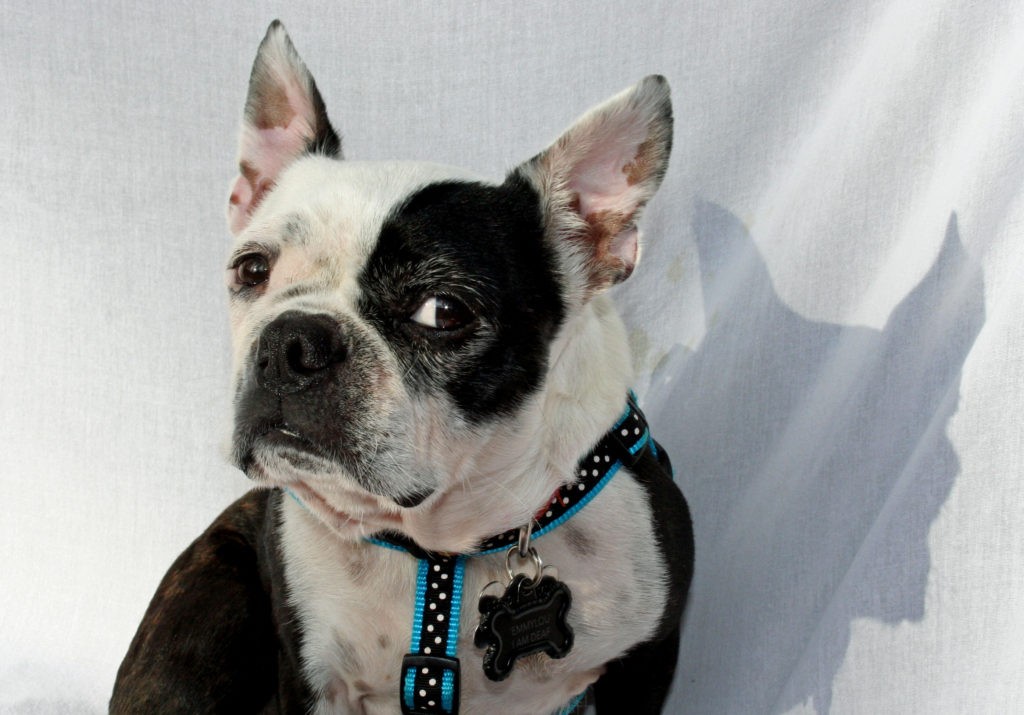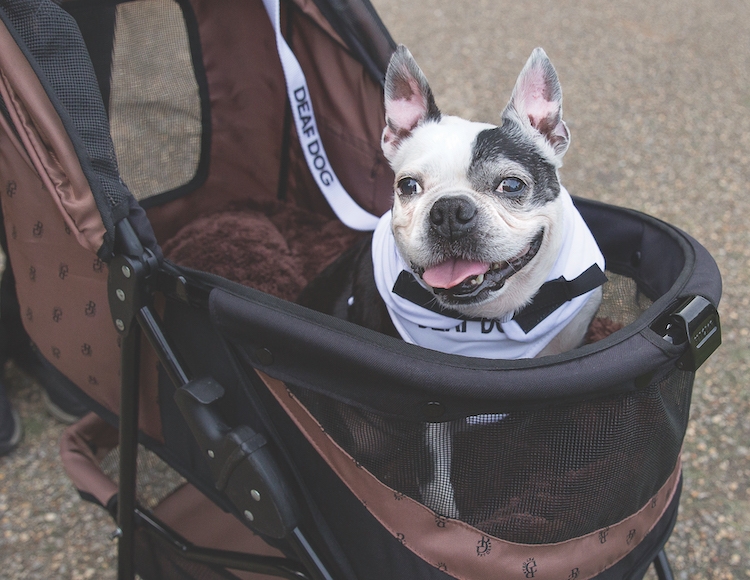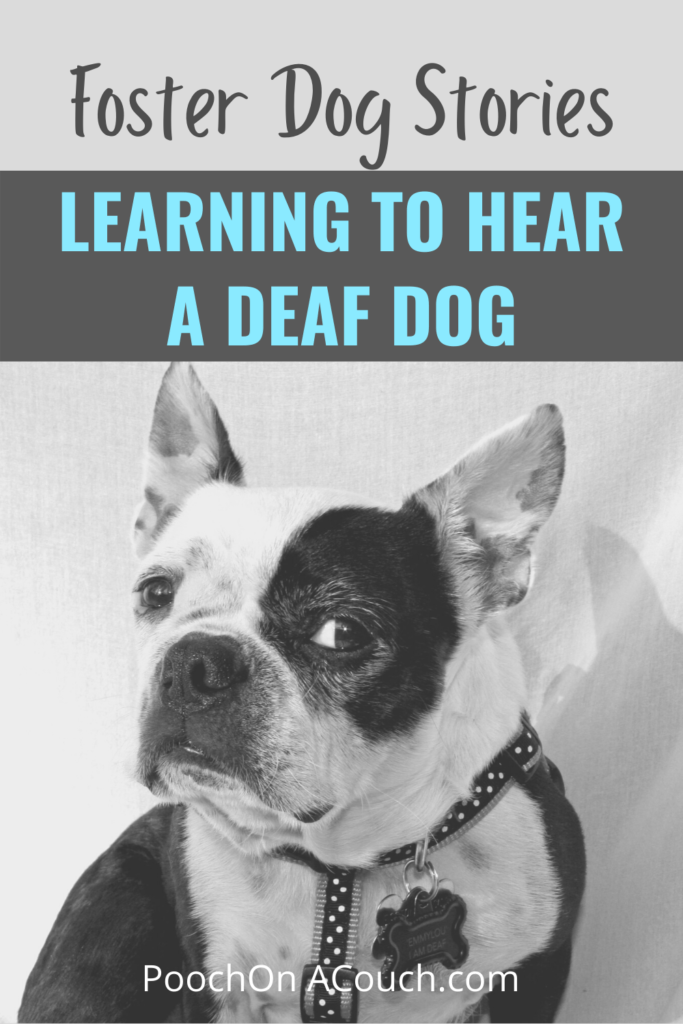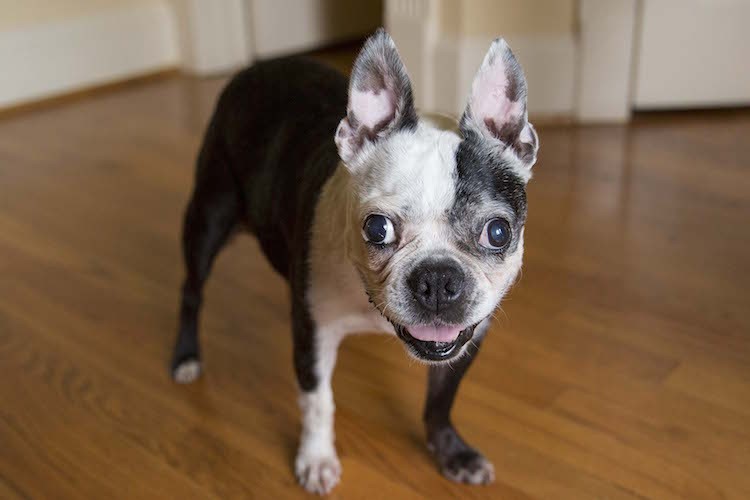Foster Dog Stories: EmmyLou
I was Emmy Lou’s fourth foster home in 4 months.
As an administrator for a rescue, particularly as the foster coordinator, I felt the unwanted expectation that I step up to the plate for this difficult foster dog. I’d already stepped up plenty. I was exhausted and I wanted my turn at an easy dog.
Nevertheless. I agreed to foster EmmyLou. Here’s our story.
Emmy Lou’s Foster Dog Story
Her geographic origin is irrelevant, she could be any breeder dump from Anytown, Anystate, USA or I imagine anywhere in the world, but she originated from a small town in east-central Alabama. She’d obviously whelped many litters in her 6-8 years of life.
Her gut was full of intestinal parasites, so full that they were migrating into her skin. Gross.
You guessed it: she tested heartworm positive – yeah. Dammit.
She was house-trained and leash trained. Hmmm. Clearly, she’d lived in a home, and at one time, was someone’s pet.
Try Me A Foster Home
The rescue first placed EmmyLou in a temporary, through-the-weekend foster home to get her out of boarding. I don’t remember details, but I know now that EmmyLou did not like boarding and created a scene. In those first days in foster care, we learned that she loved to stay near her people and she had a sweet disposition.
Her second foster family, new to fostering, were excited, eager to help, and were the first people to ever notice that EmmyLou was deaf!
It was also the first time we were able to see that EmmyLou did not like to be left alone and was very frantic when left.
The day she nipped one of them in frustration was the day the family asked me to move her to a new foster home better equipped to handle a deaf foster dog with anxiety. Because there were children in the home, it was absolutely the right request. My recollection fails me, but I think EmmyLou lived with this family less than two weeks.
Her third foster home was an expert foster home for the rescue. Everyone in the home was seasoned in fostering, knew how to manage persnickety dogs, and many dogs had recovered from medical and moderate behavioral issues under their care. They had prior experience with a deaf foster dog.
They were also a very busy family.
When Busy and Separation Anxiety Don’t Mix
I don’t know about you, but every family that I know who has a school-aged child is beyond busy.
EmmyLou’s foster family was no different: 9-5 jobs, home for a quick bite, then off for ball practice, scouts, music, or any other extracurricular activity you want to substitute here. With their busy schedule, EmmyLou became increasingly frustrated, and it showed in her behavior, then in her health. No one knew how stressed she was.
As EmmyLou’s behavior worsened, she spent more time isolated from the other dogs in the home. As her gut worsened, she became sick with bloody diarrhea. The veterinarian prescribed rounds and rounds of medications, supplements, homeopathic additives, and her gut remained upset.
When the family was home and with her, she was happy as a lark, minus the tiffs she’d get into with the other dogs, but there was no answer to her gut issues – they were steadily getting worse.
And then, it happened. Secure in her crate, she blew projectile bloody diarrhea all over the dining room drapery.
EmmyLou’s crate would now be relocated to the climate-controlled garage.
With this decision, EmmyLou’s behavior escalated to a new level. She destroyed the first crate trying to get out of it. She climbed up onto the shelves lining the garage walls, tumping over supplies stored there. Thankfully, nothing was toxic to her.
If her behavior could not be managed, she was going to hurt herself.
Frustrated, baffled, and at the end of their capabilities, this family requested she be moved a.s.a.p. I made arrangements to go get her and bring her home.
I’m Talking, No One Hears Me (or… Who’s The Deaf One??)
We had a quiet two-hour ride home, she was quiet and to herself. Little did I know how spun up and tense she really was! Home just 5 minutes, she jumped on and bit one of my two other foster dogs who then looked at me like, “what the heck?” She did it again thirty seconds later, and I promptly put her in her crate to help her decompress and settle in after her move.
I mean, that’s what we are taught to do, right? Crate and separate.
She flipped out. Panicked, grunting, pressing her head against the bars of the crate – and she never, ever stopped until the doors to the crate came open. I tried to use a baby gate, x-pens – all of my tools that I tell people to use, and nothing would settle her.
Completely at a loss, I wondered how this dog could be so badly represented to me? I knew she was quirky, I didn’t know she was nearly unmanageable. Nearly? Ha. She was unmanageable. Except, she was a nice little dog.
The next morning, I put her in the biggest crate I could find, positioned it where I thought it would be most helpful to her, and left for work. I didn’t know what to do – if I left her loose, would she try to climb my bookshelves and pull them over on top of her? The crate seemed to be the safest place for her.
I came home, and found her bedding bright red, soaking in bloody body fluids. EmmyLou was alert, active, and her gums were nice and pink. I called my vet and sent her a photo of the carnage.
“Stress” she said.
We talked about separation anxiety and the use of medication, and settled on a couple of pharmaceuticals to try. We also discussed her heartworm status. If we couldn’t get her behavior under control, we couldn’t treat her heartworm.
While waiting for those meds to work, I scheduled an appointment with my trainer to see if she had any insights. She met EmmyLou, and she and I talked about EmmyLou’s crate frustrations as a separate issue from the separation anxiety. Yahoo. Now, I had two problems, not one!
I began reading everything I could get my hands on – and I was growing concerned and hopeless. Everything I read said to not allow a dog with anxiety get to the point in their anxiety where they panic (go over threshold). That meant EmmyLou shouldn’t ever be left alone OR crated. Great.
Everything I knew, everything I read, everything I believed told me I was not capable of helping this dog. I could not stay home to follow a rehabilitation protocol. I nor the rescue could afford to provide her with human supervision while I was away.
She had to be crated for her safety. I was convinced of it. EmmyLou went to day-training a few times to try and learn to be happier in her crate. Nothing.

Learning To Listen
Two weeks passed, maybe three – and EmmyLou behaved no better and my household remained in an uproar. I’d exhausted all of my resources. The rest of the dogs were on edge, tiffs were increasing. I began to seriously regret agreeing to foster her.
The only thing I hadn’t tried was leaving her alone un-crated, with the other dogs crated. Would she be safe? I had to try.
I grabbed my iPad, propped it up somehow, set it to videotape, and left the house. Absent for no more than 20 minutes, I returned and watched my video.
It All Made Sense
What I watched made me cry.
It ALL made sense. Her behavior in the garage, the climbing, the crate, her gut, her frustration, her tiffs, all of it.
EmmyLou had been trying to say this whole time:
Listen to me. I cannot hear. I am DEAF.
I use my EYES to help me interpret my surroundings.
What I watched on that recording:
I closed the door to the house. She ran from the back door to the sofa. EmmyLou stood on the back of the sofa looking out the window until my car was out of the driveway and out of sight. She stood there for another minute, did a little mild pacing along the sofa back, then laid down on the sofa back, eyes facing the street, to wait for me to return.
I need to be able to look out of the window.
To be able to look out the window. It was all she wanted. Such a simple request.
Remember when she’d been put into the climate-controlled garage and had climbed the shelving? She was trying to reach those little windows at the top of the garage door. Trying to see out to the street. I still cry thinking about her desperation and panic.
I accommodated. For the next two years, EmmyLou and I communicated about her needs. I gave her access to the window facing the driveway.
There were other requests, too, like: don’t let dogs get excited around me, or if you are going to run errands do it all at once – the coming and going is too hard, and despite what people say about dogs not being able to tell time, I can, and I know when you stay late for work.
She was serious: Do not crate me.
Her gut issues resolved in less than a week. I kept her on her pharmaceuticals for a little while longer until her stress hormones had a chance to return to normal.
She and I gently worked on her aversion to crates, and she never overcame that issue. I never demanded that she stay in one, and she respected my efforts to ask her to try.
She would eventually choose her open-door crate as a bed on occasion, and oddly enough, she easily slept in a closed-door crate at night, as long as it was in my bedroom and I was done with my pre-bedtime activities. I don’t know why she was accepting of her crate at bedtime.
Read why my foster dogs sleep in crates.
EmmyLou would go on to be adopted by a beautiful family who gave her the best gift ever: She never ever had to be left alone at home ever again, they took her everywhere, or one person would stay home with her. And she never saw a crate again, ever.

Learning to Listen
Every foster dog has something to say to us. Not always about their stories, but about their emotions, preferences, and needs. How does your foster dog tell you they are content? frustrated? over-stimulated? anxious? How does your dog tell you not no, but hell no!
When life with a foster dog gets complicated, think about their side of the conversation. Look at the behavior, the body language and try and figure out what they are saying to you. They do whatever you can to listen to their requests.
Get a Nanny Cam.
After watching the iPad recording of her behavior as I left her alone that first time, I immediately ordered a nanny cam and I continue to use one as part of my initial evaluation for every foster dog that comes into my home. Never, ever will another dog ever have to fight so hard to be heard. Not at my house.
Disclosure: This post contains affiliate links. As an affiliate, I earn a commission on qualifying purchases made through these links, at no additional cost to you. I only recommend products I use and love or plan to purchase myself.
Check out my favorite nanny cam for dogs!
Pin Me!

Popular Posts
- HOW TO CHOOSE A DOG RESCUE AGENCY
- ULTIMATE GUIDE TO FOSTERING: 10 SKILLS YOU NEED
- VOLUNTEER IF YOU CANNOT FOSTER





